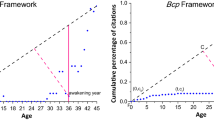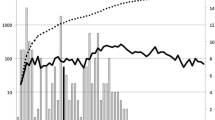Abstract
From 2010 to 2014, the Journal of Medical and Biological Engineering (JMBE) published more than twice as many articles as it did during the previous 5-year period. This increase has raised significant information management and retrieval issues related to the emergence of “big data”. Generally speaking, every publication has academic value and should be available to researchers. However, statistical assessments indicate that 95 % of studies are not cited by other publications. Some of these dormant articles could make significant contributions to medical and biological engineering research. Such studies are referred to as “sleeping beauties”. The present study develops an information “awakening” framework to explain how to extract value from sleeping beauties. The proposed framework implements a web-based system through which researchers can propose effective awakening strategies, referred to as “princes”. An analysis of experimental results found 14 sleeping beauties in JMBE, some of which were awakened by the two proposed princes, namely “keyword prince” and “H-index prince”. The results are expected to provide journals with a clear way to promote published studies, and to make their findings more readily available to scholars.








Similar content being viewed by others
References
Voronin, Y., Myrzahmetov, A., & Bernstein, A. (2011). Access to scientific publications: The scientist’s perspective. PLoS ONE, 6, e27868.
Wyatt, H. V. (1975). Knowledge and prematurity: The journey from transformation to DNA. Perspectives in Biology and Medicine, 18, 149–156.
Barber, B. (1963). Resistance by scientists to scientific discovery. American Journal of Clinical Hypnosis, 5, 326–335.
Cole, S. (1970). Professional standing and the reception of scientific discoveries. American Journal of Sociology, 76, 286–306.
Van Raan, A. F. (2004). Sleeping beauties in science. Scientometrics, 59, 467–472.
Mendel, G. (1866). Versuche über Pflanzenhybriden, Verhandlungen des naturforschenden Vereines in Brünn.
Wang, J., Ma, F., Chen, M., & Rao, Y. (2012). Why and how can “sleeping beauties” be awakened? The Electronic Library, 30, 5–18.
Li, J., Shi, D., Zhao, S. X., & Fred, Y. Y. (2014). A study of the “heartbeat spectra” for “sleeping beauties”. Journal of Informetrics, 8, 493–502.
The Digital Universe in 2020: Big Data, Bigger Digital Shadows, and Biggest Growth in the Far East. (2012). Available via http://www.emc.com/collateral/analyst-reports/idc-digital-universe-united-states.pdf.
Davenport, T. H., Barth, P., & Bean, R. (2013). How ‘big data’ is different. MIT Sloan Management Review, 54, 21–25.
Silver, N. (2012). The signal and the noise: Why so many predictions fail-but some don’t. New York: Penguin.
D Data Management: Controlling Data Volume, Velocity and Variety. (2012). Available via http://blogs.gartner.com/doug-laney/files/2012/01/ad949-3D-Data-Management-Controlling-Data-Volume-Velocity-and-Variety.pdf
Zikopoulos, P., & Eaton, C. (2011). Understanding big data: analytics for enterprise class hadoop and streaming data. New York: McGraw-Hill Osborne Media.
Mayer-Schönberger, V., & Cukier, K. (2013). Big data: A revolution that will transform how we live, work, and think. Boston: Houghton Mifflin Harcourt.
Edosio U. Z. (2014). Big data paradigm-analysis, application, and challenges. 13th Research seminar series workshop.
Braun, T., Glänzel, W., & Schubert, A. (2010). On sleeping beauties, princes and other tales of citation distributions…. Research Evaluation, 19, 195–202.
McAfee, A., & Brynjolfsson, E. (2012). Big data: The management revolution. Harvard Business Review, 90, 60–66.
Gandomi, A., & Haider, M. (2015). Beyond the hype: Big data concepts, methods, and analytics. International Journal of Information Management, 35, 137–144.
Maury, M. F. (2003). The physical geography of the sea and its meteorology. New York: Dover.
Beaty, J. J. (1966). Seeker of seaways: A life of Matthew Fontaine Maury pioneer oceanographer. Milano: Pantheon Books.
Lewis, C. L. (1927). Matthew Fontaine Maury: The pathfinder of the seas. Annapolis: Naval Institute.
Costa, F. F. (2014). Big data in biomedicine. Drug Discovery Today, 19, 433–440.
Provost, F., & Fawcett, T. (2013). Data science and its relationship to big data and data-driven decision making. Big Data, 1, 51–59.
Baumgartner, H. (2010). Bibliometric reflections on the history of consumer research. Journal of Consumer Psychology, 20, 233–238.
Radicchi, F., & Castellano, C. (2013). Analysis of bibliometric indicators for individual scholars in a large data set. Scientometrics, 97, 627–637.
Stent, G. S. (1972). Prematurity and uniqueness in scientific discovery. Scientific American, 227, 84–93.
Romans, L. J. (1986). Massive N = 2a supergravity in ten dimensions. Physics Letters B, 169, 374–380.
Polchinski, J. (1995). Dirichlet branes and ramond–ramond charges. Physical Review Letters, 75, 4724.
Garfield, E. (1979). Is citation analysis a legitimate evaluation tool? Scientometrics, 1, 359–375.
Brimblecombe, P., & Grossi, C. M. (2009). The bibliometrics of atmospheric environment. Atmospheric Environment, 43, 9–12.
Baumgartner, H. (2010). Bibliometric reflections on the history of consumer research. Journal of Consumer Psychology, 20, 233–238.
Van Dalen, H. P. (2005). Signals in science-on the importance of signaling in gaining attention in science. Scientometrics, 64, 209–233.
Li, J., & Ye, F. Y. (2012). The phenomenon of all-elements-sleeping-beauties in scientific literature. Scientometrics, 92, 795–799.
Burrell, Q. L. (2005). Are “sleeping beauties” to be expected? Scientometrics, 65, 381–389.
Xu, F., Liu, W. B., & Mingers, J. (2015). New journal classification methods based on the global H-index. Information Processing and Management, 51, 50–61.
Garfield, E. (1972). Citation analysis as a tool in journal evaluation. Science, 178, 471–479.
Hirsch, J. E. (2005). An index to quantify an individual’s scientific research output. Proceedings of the National Academy of Sciences of the United States of America, 102, 16569–16572.
Alonso, S., Cabrerizo, F. J., Herrera-Viedma, E., & Herrera, F. (2009). H-index: A review focused in its variants, computation and standardization for different scientific fields. Journal of Informetrics, 3, 273–289.
Liu, Y., & Yang, Y. (2014). Empirical study of L-Sequence: the basic H-index sequence for cumulative publications with consideration of the yearly citation performance. Journal of Informetrics, 8, 478–485.
Rousseau, R. (2006). New developments related to the Hirsch index.
Ausloos, M. (2015). Assessing the true role of coauthors in the H-index measure of an author scientific impact. Physica A: Statistical Mechanics and its Applications, 422, 136–142.
Ball, P. (2005). Index aims for fair ranking of scientists. Nature, 436, 900.
Van Raan, A. F. (2006). Comparison of the Hirsch-index with standard bibliometric indicators and with peer judgment for 147 chemistry research groups. Scientometrics, 67, 491–502.
dos Santos Rubem, A. P., & de Moura, A. L. (2015). Comparative analysis of some individual bibliometric indices when applied to groups of researchers. Scientometrics, 102, 1019–1035.
Du, H., Li, B., Brown, M. A., Mao, G., Rameezdeen, R., & Chen, H. (2014). Expanding and shifting trends in carbon market research: A quantitative bibliometric study. Journal of Cleaner Production, 103, 104–111.
Braun, T., Glänzel, W., & Schubert, A. (2006). A Hirsch-type index for journals. Scientometrics, 69, 169–173.
Banks, M. G. (2006). An extension of the Hirsch index: Indexing scientific topics and compounds. Scientometrics, 69, 161–168.
Bar-Ilan, J. (2008). Which H-index?-A comparison of WoS, Scopus and Google Scholar. Scientometrics, 74, 257–271.
Meho, L. I., & Rogers, Y. (2008). Citation counting, citation ranking, and H-index of human–computer interaction researchers: A comparison of Scopus and Web of Science. Journal of the American Society for Information Science and Technology, 59, 1711–1726.
Meho, L. I., & Yang, K. (2007). Impact of data sources on citation counts and rankings of LIS faculty: Web of Science versus Scopus and Google Scholar. Journal of the American Society for Information Science and Technology, 58, 2105–2125.
Franceschini, F., & Maisano, D. (2010). The citation triad: an overview of a scientist’s publication output based on Ferrers diagrams. Journal of Informetrics, 4, 503–511.
Chen, C. P., & Zhang, C. Y. (2014). Data-intensive applications, challenges, techniques and technologies: A survey on big data. Information Sciences, 275, 314–347.
Kaisler, S., Armour, F., Espinosa, J. A., & Money, W. (2013). Big data: issues and challenges moving forward. Proceedings IEEE Hawaii International Conference, 46, 995–1004.
Gandomi, A., & Haider, M. (2015). Beyond the hype: Big data concepts, methods, and analytics. International Journal of Information Management, 35, 137–144.
Hashem, I. A. T., Yaqoob, I., Anuar, N. B., Mokhtar, S., Gani, A., & Khan, S. U. (2015). The rise of “big data” on cloud computing: review and open research issues. Information Systems, 47, 98–115.
Sheikh, N. (2013). Implementing analytics: A blueprint for design, development, and adoption. San Francisco: Morgan Kaufmann.
Tscharntke, T., Hochberg, M. E., Rand, T. A., Resh, V. H., & Krauss, J. (2007). Author sequence and credit for contributions in multiauthored publications. PLoS Biology, 5, e18.
Wright, S. (1921). Correlation and causation. Journal of Agricultural Research, 20, 557–585.
Acknowledgments
This research was supported in part by the Ministry of Science and Technology of the Republic of China, Taiwan, under grants MOST 103-2511-S-025-001-MY3 and MOST 104-2511-S-025-002-MY3. The author would like to acknowledge the contributions of graduate student Jyun-You Lin, who assisted with the experiment planning.
Author information
Authors and Affiliations
Corresponding author
Rights and permissions
About this article
Cite this article
Huang, TC., Hsu, C. & Ciou, ZJ. Systematic Methodology for Excavating Sleeping Beauty Publications and Their Princes from Medical and Biological Engineering Studies. J. Med. Biol. Eng. 35, 749–758 (2015). https://doi.org/10.1007/s40846-015-0091-y
Received:
Accepted:
Published:
Issue Date:
DOI: https://doi.org/10.1007/s40846-015-0091-y




